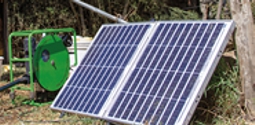They may appear expensive to buy at first, but solar pumps will very quickly pay for themselves simply by the fact that, once correctly installed, they operate at zero cost.
And, in the case of borehole pumps, they may even pay for themselves before they are installed.
Borehole pumps
Solar borehole pump kits are easily available in South Africa. These comprise a pump and motor, cabling, a controller and solar photovoltaic (PV) panels of sufficient size and capacity to drive the pump.
The great advantage of a stand-alone solar borehole pump is that it requires no (expensive) trenching and cabling to connect it to the property’s mains supply. In a deep borehole, requiring a large three-phase pump, the cost of four-core armoured cable, plus trenching, can easily equal or outweigh the cost of the pump and piping itself.
Solar pump installation is relatively simple: Drop the pump down the borehole (to the correct depth, of course), connect it to the controller and connect the controller to the panels, point the panels at the sun and, hey presto, water will flow.
Panels are key
The solar panels are, of course, the key to the operation. To work optimally they need to be raised above anything that could obstruct the rays of the sun, such as trees. And, being relatively delicate, they need some form of protection from livestock. As a result, they are usually mounted up a pole, pointing at the sun.
But here’s the catch: Two or three solitary panels mounted up a pole in the middle of the veld are an efficient advertisement of the fact that nearby something of value, such as an expensive borehole pump, is available for stealing. One can partly reduce this problem by mounting the panels on a pole some distance from the pump, but this brings one back to the cost of a connecting cable and trenching.
What happens when the sun isn’t shining?
And, of course, a solar borehole pump will only operate when the sun shines. To make it pump water at night requires the PV panels to charge batteries during the day which will power the pump at night. But batteries don’t last forever, and add considerably to the cost of the installation.
The way round this is to install a tank on a stand, or build a reservoir, which the borehole can fill during the day, and which will provide you with the necessary water throughout both day and night.
All the initial costs aside, the fact that it operates at zero running cost, a solar installation is a worthwhile option to investigate when equipping a new hole or replacing an existing pump.
Other solar pumps
If a solar borehole pump is an option, what about other solar pumps? Small solar pond pumps are freely available, often based on solar bilge pumps fitted to leisure boats and yachts.
And, of course, any household that has gone totally off-grid will have made arrangements for its booster pumps, pool pumps etc to be powered by its solar set-up.
Which leaves us with only portable water pumps, which are usually petrol or diesel-powered.
Now, however, a Dutch company named Futurepump has developed a small range of portable solar-powered pumps especially-suited to the needs of smallholder farmers who wish to irrigate their crops from rivers or dams, or fill tanks to feed their households, hydroponic systems, and livestock troughs etc.

Just like motorised portables these are fitted into tubular steel frames for easy transportation, and are connected by a short cable to a couple of PV panels mounted on a small angular frame.
25mm or 32mm piping is connected to the units and, during hours of sunlight, pumping happens silently, pollution-free, and at no cost. The units, including pump and PV panels, retail for under US$700 (about R9 800). They are available in a number of African, and some Asian, countries, but not South Africa…yet.
This is Part Three in a five-part series on Pumps. To read the rest of the series, click here.

